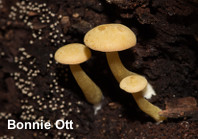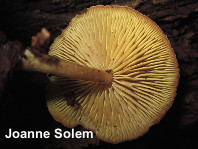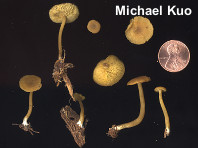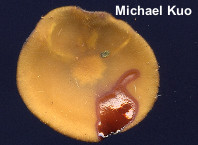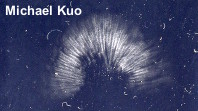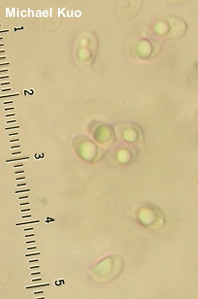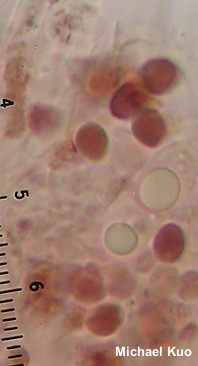| Major Groups > Gilled Mushrooms > Pale-Spored > Collybioid > Callistosporium luteo-olivaceum |

|
Callistosporium luteo-olivaceum [ Basidiomycota > Agaricales > Tricholomataceae > Callistosporium . . . ] by Michael Kuo This little mushroom is a decomposer of deadwood--primarily the wood of conifers. It has an olive to yellow cap, yellow gills, and a white spore print. Ho-hum. Truth be told, Callistosporium luteo-olivaceum is pretty boring, though it becomes slightly more interesting with the application of KOH (its cap turns purplish red) or under the microscope, where its spores turn purple in KOH. Actually, about that last bit: it's a little complicated. The spores turn purple in KOH only after the mushroom has been dried for the herbarium—and even then, only some of them accomplish the color change (particularly those that are still in contact with the basidia). Tricholomopsis decora and Tricholomopsis sulphureoides can look similar, and also turn red with KOH (despite at least one erroneous report in a field guide). But these species have scaly to fibrillose caps (at least, when fresh), mild taste, and several important microscopic differences. Callistosporium graminicolor, separated by Lennox (1979) on the basis of its longer spores and smaller fruiting bodies, is now considered to be a form of Callistosporium luteo-olivaceum. Thanks to Joanne and Bob Solem for collecting, documenting, and preserving some of the illustrated and described specimens; their collection is deposited in The Herbarium of Michael Kuo. Description: Ecology: Saprobic on well-decayed deadwood of conifers and, less often, on the deadwood of hardwoods; growing alone or gregariously; occasionally on wood so far decayed that the mushrooms appear terrestrial, and sometimes on buried wood; summer, fall, and winter; apparently widely distributed in North America. The illustrated and described collections are from Illinois and Maryland. Cap: 1–4 cm; convex, becoming planoconvex, broadly bell-shaped, or flat; at first very finely dusted, but soon bald; somewhat moist when fresh; dark olive to olive yellow or merely golden yellow, without olive shades; often changing color markedly as it dries out, creating a two-toned appearance. Gills: Attached to the stem, sometimes by means of a notch; close; short-gills frequent; usually yellow or golden yellow, but sometimes whitish. Stem: 3–4 cm long; 2–3 mm thick; when young finely dusted overall, becoming bald over the upper half or overall with age; hollowing; often grooved or flattened; colored like the cap; basal mycelium white, prominent. Flesh: Thin; insubstantial; colored like the cap or whitish. Odor and Taste: Odor not distinctive, or a little fragrant; taste bitter. Chemical Reactions: KOH on cap surface purplish red. Spore Print: White. Microscopic Features: Spores 3.5–5.5 x 2.5–3.5 µm; ellipsoid; smooth; with an apiculus; inamyloid; hyaline and uniguttulate in KOH when fresh, and when free floating in mounts of dried material—but containing brownish purple inclusions when in contact with the hymenium or other tissues. Lamellar trama parallel. Basidia 4-spored; some developing purple inclusions in a KOH mount. Pleurocystidia absent. Cheilocystidia inconspicuous; about the length of the basidia, clavate to contorted or branched. Pileipellis a cutis of elements 3–5 µm wide, with clavate cystidia (especially in young specimens); brown in KOH. Clamp connections absent. REFERENCES: (Berkeley & Curtis, 1859) Singer, 1946. (Saccardo, 1887; Lennox, 1979; Redhead, 1982; Arora, 1986; Gándara & Guzmán, 2006; Miller & Miller, 2006; Trudell & Ammirati, 2009; Kuo & Methven, 2014; Siegel & Schwarz, 2016.) Herb. Kuo 08290202, 07250401, 10010501, 06301601. This website contains no information about the edibility or toxicity of mushrooms. |
© MushroomExpert.Com |
|
Cite this page as: Kuo, M. (2016, August). Callistosporium luteo-olivaceum. Retrieved from the MushroomExpert.Com Web site: http://www.mushroomexpert.com/callistosporium_luteo-olivaceum.html |
